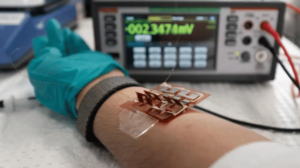Wearable technology has transformed the way we monitor health, fitness, and daily life. From smartwatches tracking heart rates to fitness bands measuring steps, wearables have become an integral part of our routines. But a groundbreaking innovation from researchers at Queensland University of Technology promises to redefine the future of wearables: body-heat-powered devices. By harnessing body heat as a power source, these wearables eliminate the need for traditional batteries, offering not only environmental benefits but also potential solutions to emerging health concerns like electromagnetic fields (EMFs). Let’s explore why this advancement can be a game-changer.
The Science of Body-Heat Power
The innovation relies on the Seebeck effect, a principle of thermoelectric power generation where a temperature difference between two surfaces creates an electrical current. Researchers have developed an ultra-thin, flexible thermoelectric film capable of converting body heat into electricity. This film, measuring just 0.3mm thick, can generate up to 35 microwatts per square centimeter when in contact with human skin. Its flexibility ensures comfort, efficient heat transfer, and seamless integration into various wearable devices.
Key Features of This New Tech:
- Ultra-thin Design: The 0.3mm thickness allows wearables to remain lightweight and comfortable.
- High Power Density: The ability to generate sufficient energy for small electronic devices.
- Environmentally Friendly: Eliminates the need for disposable batteries and reduces e-waste.
- Scalability: Compatibility with existing manufacturing processes makes commercial production viable.
This technology opens doors for a new era of self-sustaining wearables, offering a new level of convenience, reliability, and sustainability.

Applications of Body-Heat Powered Wearables
The versatility of this thermoelectric film allows for diverse applications across industries:
Healthcare Monitoring
Devices like pulse oximeters and ECG monitors can operate continuously without requiring battery replacements or frequent charging. This ensures uninterrupted tracking of vital signs, which is critical for patients with chronic conditions or those undergoing intensive treatment. For instance, hospital-grade wearables could monitor patients remotely for extended periods, reducing hospital stays and improving healthcare outcomes.
Fitness and Lifestyle
Smartwatches, fitness bands, and other wearables could function autonomously, freeing users from the hassle of charging devices daily. This is especially beneficial for athletes, hikers, or travelers who often lack access to charging facilities. Imagine a fitness tracker that never runs out of power during a marathon or a smartwatch that lasts through days of trekking through the wilderness.
Smart Clothing
The integration of this film into textiles could lead to clothing that not only regulates body temperature but also powers small devices. For example, running in a shirt that charges your fitness tracker or gloves that power navigation aids exit sci-fi and become real possibilities. This innovation could, and likely would, extend to military and emergency services, where powered garments could support communication and tracking devices in remote or harsh environments.
Consumer Electronics
Beyond wearables, this technology has potential applications in cooling systems for smartphones and laptops, improving performance and reducing energy consumption. By integrating thermoelectric films, devices could use the heat they generate to partially power themselves, enhancing efficiency and reducing dependency on external charging.
Environmental Benefits
One of the most compelling aspects of body-heat-powered wearables is their environmental impact. Traditional batteries, often used in wearables, pose significant environmental challenges:
- Resource-Intensive Production: Mining for lithium and other materials used in batteries contributes to severe habitat destruction and pollution.

- Electronic Waste: Disposable and rechargeable batteries have limited lifespans, creating tons of e-waste annually.
- Toxic Chemicals: Improperly discarded batteries can release harmful chemicals into the environment, contaminating soil and water.
By eliminating the need for batteries, body-heat-powered wearables address these issues directly. Reduced dependency on disposable batteries means less mining, lower energy usage in production, and a significant decrease in e-waste. This innovation sets the stage for more sustainable consumer electronics, aligning with global goals to reduce carbon footprints and reduce anthropogenic climate change.
A Safer Option for EMF Concerns
Electromagnetic fields (EMFs) emitted by electronic devices have been a growing concern, with emerging studies suggesting links to sleep disturbances, cognitive issues, and other more serious long-term health risks. Wearables relying on wireless connectivity and rechargeable batteries add to one’s cumulative exposure.
Body-heat-powered wearables offer a safer alternative by:
- Reducing EMF Exposure: Eliminating the need for wireless charging and minimizing electronic components that emit EMFs.

- Encouraging Simplicity: With no reliance on charging docks or wireless power sources, these devices can be designed to reduce prolonged EMF emissions.
For those looking to minimize their EMF exposure, body-heat-powered wearables present an attractive solution. By powering devices through thermoelectric means, they not only reduce reliance on external charging but also minimize additional sources of EMFs.
Complementary EMF Protection Innovation
While body-heat-powered wearables reduce some EMF exposure, many other electronic devices still emit EMFs in our daily lives. This is where Aires Tech’s technology comes in. Aires Tech provides scientifically backed solutions to diffract EMFs into a more biologically compatible form, reducing their impact on our bodies. By incorporating Aires Tech products, users can enjoy additional peace of mind when using wearables and other electronic devices. This combination of advanced technology and proactive protection creates a safer and healthier environment for users.

Challenges and the Road Ahead
Like any emerging technology, body-heat-powered wearables face challenges:
- Power Limitations: While sufficient for small devices, the current power output may not support energy-intensive applications like smartphones or larger wearables.
- Cost of Production: Advanced materials and processes could make initial production expensive, though scalability may reduce costs over time.
- Market Adoption: Convincing consumers and manufacturers to transition from battery-powered devices to thermoelectric solutions will require awareness and incentives.
Despite these hurdles, the promise of sustainable, self-sufficient wearables makes this a technology worth pursuing. As research progresses, power output and cost efficiency are likely to improve, enabling broader adoption. Collaboration between researchers, manufacturers, and policymakers will play a crucial role in overcoming these challenges and accelerating the deployment of this technology.
The Future of Wearables
Body-heat-powered wearables represent a significant leap forward in the evolution of personal technology. By combining comfort, sustainability, and reduced EMF exposure, they address many of the limitations of current devices. As we look to the future, advancements in thermoelectric materials and manufacturing processes will unlock even greater potential for this technology.
Imagine a world where smartwatches, fitness bands, and health monitors run seamlessly without ever needing a battery change or charge. Beyond convenience, these wearables could pave the way for more eco-conscious consumer habits, fostering a culture of sustainability. The integration of thermoelectric films into textiles, accessories, and other consumer products could create a new wave of energy-efficient innovations.
Moreover, this development highlights the importance of cross-disciplinary collaboration. By bringing together expertise in material science, electronics, and environmental studies, researchers are pushing the boundaries of what wearable technology can achieve. Partnerships with industries such as healthcare, fashion, and consumer electronics will further expand the possibilities for these innovations.
Conclusion
The development of body-heat-powered wearables isn’t just a technological breakthrough; it’s a step toward a safer, greener future. By harnessing body heat as a renewable energy source, these devices reduce reliance on traditional batteries, address environmental concerns, and offer a safer alternative for those wary of EMF exposure. With complementary solutions like Aires Tech ensuring robust EMF safety, this innovation sets the stage for a much more harmonious relationship between technology and human health.
As we embrace these advancements, the potential applications are vast, spanning healthcare, fitness, fashion, and beyond. Body-heat-powered wearables stand as a testament to the power of innovation, showing how science can harmonize convenience, sustainability, and safety to create a better world. By supporting these groundbreaking technologies, we can encourage a future where wearable devices enhance our lives while also protecting our well-being and that of the planet.











